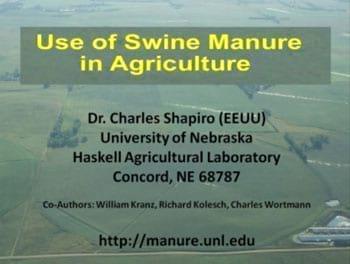The French and Dutch Experiences in Controlling Odour on Farms
The influence of intensive agriculture on both the environment at large and within livestock buildings is receiving the highest priority in research programmes. In many cases emissions are a limiting factor for the location and operation of animal production facilities throughout the world. Odours from livestock production are perplexing mixtures of chemical compounds and have become a severe social problem in many countries. Some of the compounds will have health damaging effects as well.
Ammonia was choosen as an indicator of air quality problems due to its influence on the well-being of livestock and stockmen together with its influences on atmospheric pollution. Numerous workers have noted the important adverse effects of ammonia on human health. Recent reports have been made by Nowak (1995) for Germany and Tielen et al. (1995) for the Netherlands and in the United Kingdom by Whyte et al. (1995).
In addition there are many reports of reduced animal performance and reduced health status in poor environmental conditions (e.g. Attar and Brake, 1988; Emsinger et al., 1990; Roberston et al., 1990; Drummond et al., 1980). Recent reports from the Royal Veterinary and Agricultural University of Denmark have shown that even extremely short exposure duration can be harmful. Exposure of pigs to 50 ppm ammonia for 20 minutes a day, on four occasions only, seriously reduced animal performance between 37 and 90 kg liveweight (Figure 1). In addition, the same authors found in further experiments that ammonia seriously reduced respiratory health.
Another important effect of aerial ammonia is the delay of puberty, even at the level of 20 ppm, as shown by Malayer et al. (1988).
The seriousness of the problems caused by aerial ammonia is underlined by a law (Health and Safety Executive, 1989) in the United Kingdom. The levels of substances to which workers can be exposed are regulated in order to protect respiratory health of the worker. Ammonia is closely controlled by this legislation with levels of 25 to 35 ppm allowing the presence of the worker for only 10 minutes per day. When the level of ammonia exceeds 35 ppm the worker is not allowed in that building without a respirator. Even if these regulations are kept by the pig worker, the animals are subjected to the gases for 24 hours daily.
In spite of all reports and legislation concerning the negative impact on health and performance, ammonia in pig buildings in the Netherlands is not regarded as a problem (e.g. van der Voorst, 1991; Verdoes, 1990; Kemme et al., 1993) because levels will be below 10 ppm when practising good hygiene and optimum ventilation, which is contrary to experiences in other countries.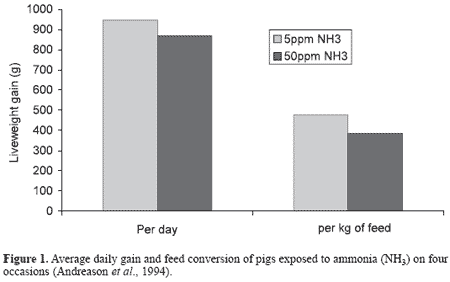
Consequently two studies under Central European circumstances were conducted to establish the levels of ammonia in pig buildings and to test the effect of Yucca schidigera extract (De-Odorase, Alltech Inc.) on ammonia concentrations and animal performance. De-Odorase was choosen as a means to reduce atmospheric ammonia since a number of people (e.g. Mader and Brumm, 1987; Cole and Tuck, 1995; Ender et al., 1993; Lyons, 1997) have reported its ability to reduce ammonia and odour and to improve animal performance.
The ammonia survey
METHODS
The first study was conducted in the Netherlands during 1994–1995 (Schuerink, 1995) followed by a study in France during 1996–1997 (Morel, 1997). To establish ammonia levels in the Netherlands, the survey was conducted on a sample of 27 farms representing a wide range of farm types in terms of feed characteristics, feeding system, floor type, stocking density and ventilation systems. To investigate the effects of Yucca extract on aerial ammonia and pig performance, a total of 900 and 5,780 pigs, respectively, were involved on five farms in the Netherlands and six farms in France. Pigs on each farm were equally divided over control and trial groups. Trial groups were fed the same feed as the control groups except for the addition of 120 g De-Odorase per tonne of feed for the trial groups.
In the Netherlands measurements for both control and trial groups were done at the same time, whereas in France 80% of all observations for the control groups were done in summer whereas 44% of the measurements for the trial groups were done in winter. Atmospheric ammonia levels were measured at least three times per fattening period using Dräger diffusion tubes for an 8 hour period situated 1 metre above the floor in the pig building. The Dräger tubes were validated in a study comparing them with a wet chemical method at IMAG Wageningen (Vijn, 1995). No significant difference was shown between the two techniques in quantifying ammonia concentrations.
RESULTS
Overall situation
The levels of ammonia measured in Dutch pig buildings are given in Figure 2. The results are interesting in that there was a wide range and the values were considerably higher than would be expected from previous reports. Very few values fell in the range that is suggested might be achieved with good management and ventilation. In the period August–September, 75% of all atmospheric ammonia concentrations were above 10 ppm; whereas in winter time more than 90% of the measurements exceeded 10 ppm. The averages were 20 and 30 ppm for summer and winter, respectively, and differed significantly (P<0.01).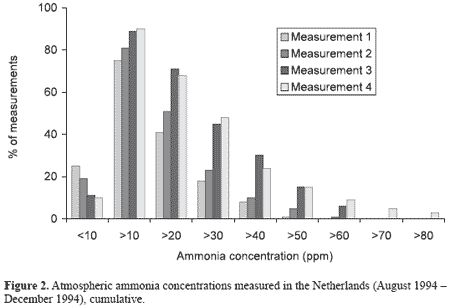
The ammonia concentrations observed on French farms are given in Figure 3. These results confirm the Dutch findings regarding the differences in distribution between summer and winter. In the summer 63% of the readings exceeded 20 ppm, whereas in winter almost 90% of all measurements were found to be above 20 ppm. The averages differed significantly (P<0.0001) and were 27 and 47 ppm, respectively, for summer and winter.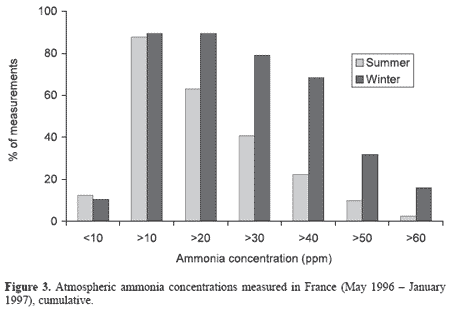
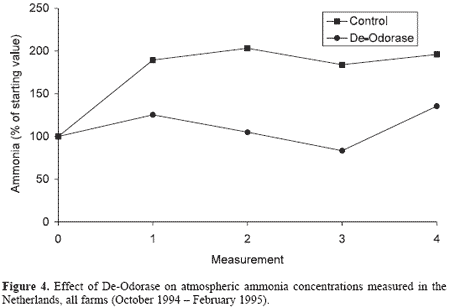
Effect of De-Odorase on atmospheric ammonia
The use of De-Odorase in the diet (120 g/tonne) was effective in reducing ammonia under practical farm conditions in both the Netherlands and France. In the Netherlands ammonia had been measured before the trial started and on four occasions during the trial phase, at days 10, 40, 70 and 100 after the start of the fattening period. In France the four measurements were taken at 10, 40 and 60 days after entry into the fattening unit and 2 weeks before the removal of the pigs. The average reductions in atmospheric ammonia in response to De-Odorase were 42.5 and 28.5% for the Netherlands and France studies, respectively. The findings are shown in Figures 4 (Dutch, P<0.01) and 5 (French, P<0.001). Furthermore, it was estimated that the reductions in ammonia obtained by De-Odorase equal an increase in practised ventilation rate of 200%, which will induce respiratory problems.
Effect of De-Odorase on animal performance
The incorporation of De-Odorase in the pig diet improved certain aspects of animal performance in both countries (Table 1). From both studies it can be concluded that De-Odorase improved efficiency and reduced mortality (P<0.05). Decreased mortality in this regard reflected improved health status of the animals due to reduced ammonia, which was underlined by the reduced costs of medication (P<0.02) in the French study.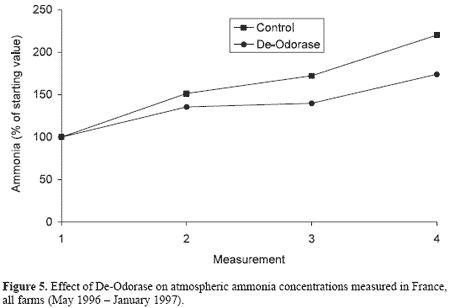
Conclusions
As an example for Central European circumstances, these surveys in the Netherlands and France show that ammonia levels can be extremely high.
These levels and the frequency of their occurrence are much higher than was believed and there is a need for reduction to levels below those which can have consequences on both pigs and stockmen.Ventilation needs to be adequate for the well being of the animal, but is constrained by the need to maintain house temperature. It has been shown that De-Odorase reduces ammonia levels significantly and improves animal performance in terms of feed conversion ratio, mortality and reduced costs of medication while maintaining the normal ventilation rate.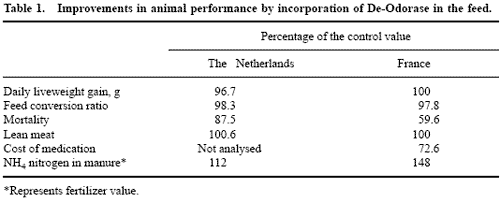
References
Andreason, M., P. Baeckbo and K. Nielsen. 1994. The effect of aerial ammonia on the MIRD complex. Proceedings 13th International IPVS Congress. Bangkok, Thailand. p. 429.
Attar, A.J. and J.T. Brake. 1988. Ammonia control: Benefits and trade-offs. Poultry Digest, August, 1988.
Cole, D.J.A. and K. Tuck. 1995. Using Yucca to improve pig performance while reducing ammonia. In: Biotechnology in the Feed Industry, Proceedings of the 11th Annual Symposium (T.P. Lyons and K.A. Jacques, eds), Nottingham University Press, Loughborough, Leics, UK. pp. 421–425.
Drummond, J.G., S.E. Cursi, J. Simon and H.W. Norton. 1980. Effects of aerial ammonia on growth and health of young pigs. J. Animal Sci. 50:1085.
Emsinger, M.E., J.E. Oldfield andW.W. Heinemann. 1990. Animal Behaviour and Environment. In: Feed and Nutrition (M.E. Emsinger et al., eds), Emsinger Publishing Co., Clovis, California. p. 652.
Ender, K., G. Kuhn and K. Nurnberg. 1993. Reducing boar taint by Yucca extract (De-Odorase). EAAP-Conference Aarhus, 16–19 August 1993, Vol. II. p. 2.16.
Health and Safety Executive. 1989. Occupational exposure limits 1989. Guidance Note 40/89. HMSO: London.
Kemme, P.A.,A.W. Jongbloed, B.M. Dellaert and F. Knol-Kramer. 1993. The use of a Yucca schidigera extract a ‘urease inhibitor’ in pig slurry. In: Nitrogen Flow in Pig Production and Environmental Concequences. (M.W.A. Verstegen, L.A. den Hartog, G.J.M. van Kempen and J.H.M. Metz, eds). EAAP Publication No. 69, 1993. pp. 330–335.
Lyons, T.P. 1997. A new era in animal production. In: Biotechnology in the Feed Industry, Proceedings of the 13th Annual Symposium (T.P. Lyons and K.A. Jacques, eds), Nottingham University Press, Loughborough, Leics, UK. pp. 1–13.
Mader, T.L. and M.C. Brumm. 1987. Effect of feeding sarsaponin in cattle and swine diets. J. Animal Sci. 65:9.
Malayer, J.R., K.E. Brandt, M.L. Green, D.T. Kelly, A.L. Sutton and M.A. Diekman. 1988. Influence of manure gases on the onset of puberty in replacement gilts. Anim. Prod. 46:211–282.
Morel, A. 1997. Effets de l’incorporation de De-Odorase dans l’aliment porc charcutier. Thesis, Ecole Nationale Vétérinaire d’Alfort, Paris, France. Nowak, D. 1995. Respiratory health and pig farmers. 46th Annual Meeting of the European Association of Animal Production. EAAP, (abstract). p. 151.
Robertson, J.F., D.Wilson andW.J. Smith. 1990. Atrophic rhinitis: The influence of aerial environment. Animal Production 50:173–182.
Schuerink, H.G. 1995. Ammonia, take a deep breath and run; ammonia levels in piggeries in the Netherlands. Thesis, Christelijke Agrarische Hogeschool, Dronten, the Netherlands.
Tielen, M.J.M., L. Preller, P. v. Gullick and A.R.W. Elbers. 1995. Health status of Dutch pig farmers and veterinarians. 46th Annual Meeting of the European Association of Animal Production. EAAP, (abstract). p. 151. Verdoes, N. 1990. Naar stallen met beperkte ammoniak-uitstoot, deel 3. ‘s Gravenhage.
van derVoorst, P. 1991. Stalklimaatsfactoren: Metingen en interpretatie. Boxtel. Vijn, T.K. 1995. Vergelijk Methoden Ammoniak Concentratie Metingen. (Comparison of different methods of measuring ammonia concentrations). Afd. Mesttechnologie, IMAG-DLO.
Whyte, R.T., P.A.M. Williamson and J. Lacey. 1995. Epidemiological studies on the health of workers in the poultry industry. 46th Annual Meeting of the European Association of Animal Production. EAAP, (abstract). p. 152.
Authors: D.J.A. COLE1, H.G. SCHUERINK2 and A. MOREL3
1 Nottingham Nutrition International, Loughborough, Leics, UK
2 Alltech Netherlands, Capelle aan den Ijssel, the Netherlands
3 Ecole Nationale Vétérinaire d’Alfort, Paris, France
We run 80 producing sows with 20 to 30 replacement gilts (for our use and sale) along with 10 boars. We will raise about 40 piglets to finish (all the room we have). We usually have about 200+/- piglets on hand. There are about 350 pigs producing odor waste daily.
We installed a methane gas plant and all cages have a runway to the input of the pre-mixing tank. All manure swept up is wheeled to the tank. In the mixing tank we run the manure through a mixing using waste water that is also directed into the tank. When mixed the liquid manure is run into the methane plant. The plant output is odor free manure/fertilizer that is sold or moved to our rice fields.
The farm is surface cleaned right after morning feeding and then deeper cleaned during the day, often twice a day if needed. All pens are deep cleaned prior to a new batch of pigs (or a sow or boar or gilt) goes into that pen. We attempt to keep all of the farm clean at all times. Not only clean from manure but clean from dirt and grim.
EM is also used to wash down areas.
Why? Because we live right on the side of the village and villagers do not like smell from our farm. Also, I know if the workers keep a clean farm the will also take good care of the livestock on the farm. Our farm is often subject to surprise visits from the Thai Government agencies and we always pass with flying colors. And the pigs stay healthier! Lastly, buyers know that they need to, and do, pay a little more for our pigs as they know they are raised with kindness and with care.
Other benefits: the local government livestock office uses our farm for a model farm when they are training. They often send people to our farm when asked where they can purchase pigs. The COOP has a program where their members can raise piglets to market (usually under 20 piglet to finish farms). The piglets in the program need to be approved BUT if their member purchases from our farm they are automatically approved. A farm needs all of the connections possible in order to make a profit as the price of feed makes the margin low.
And odor; keeping the attitude of cleanliness will result in odorless (or close to) farming.
You and the farm staff need to maintain that attitude and every thing else should fall into place. My mother brought us up saying, "Cleanliness is next to Godliness!" - now how could a man let his mother down?
Good luck and God Bless,
Randall
There are several ways by which we can control livestock odours one of which we will discuss now. You see, when you keep pigs and don't take good care of the pens/ farm there is nothing you can do, the odour will always be embarrassing. But when you take good care of the farm the place will odourless. You can equally dig a skeptic tank and always wash the waste into the skeptic tank you will see that the odour will be controlled. Also when you wash the pheases often you will see that the odour will equally be controlled...









